Fiskars Billhook: Product Review
We independently evaluate all recommended products and services. If you click on links we provide, we may receive compensation.
A versatile and innovative tool that will quickly become your "go-to" for just about anything in the garden.
I just tested one of the coolest new products from Fiskars, their 13” Billhook. Think of it as a “Leatherman” multi-tool, but used for the garden and landscape. As Fiskars puts it, “It’s a 6” hooked blade for trimming shoots and stems, dividing plants, edging borders, and more in your yard and garden”. It’s part hatchet, part machete, part hook-knife, part saw, part scraper, part weeder, and so much more. It’s got lots of sharp edges, making it an ideal cutting and digging tool for a variety of gardening and landscape projects. And all those sharp edges are protected (and protect you) by a nice nylon sheath that comes with the product.
Packaging
Included in the package with the Billhook is a nylon sheath and a placard with pictures of possible uses of the product.
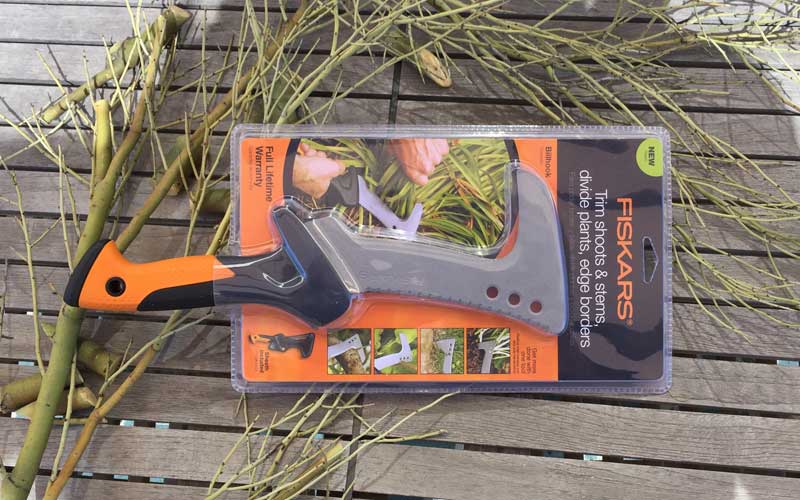
Nylon Carrying Sheath
The Billhook comes with a very well constructed nylon carrying sheath that really protected me from all the sharp edges when carrying it around. A Velcro top closure and a strap to hold the handle inside the sheath make for a secure fit.
It also comes with a sewn-in belt loop. The belt loop is attached at a perfect spot for easy carry and with the handle pointing up for easy access. It can be worn on either the left or right side depending on your preference. Note that you’ll have to use both hands to place the Billhook in the sheath or remove it – it doesn’t just slide in and out.
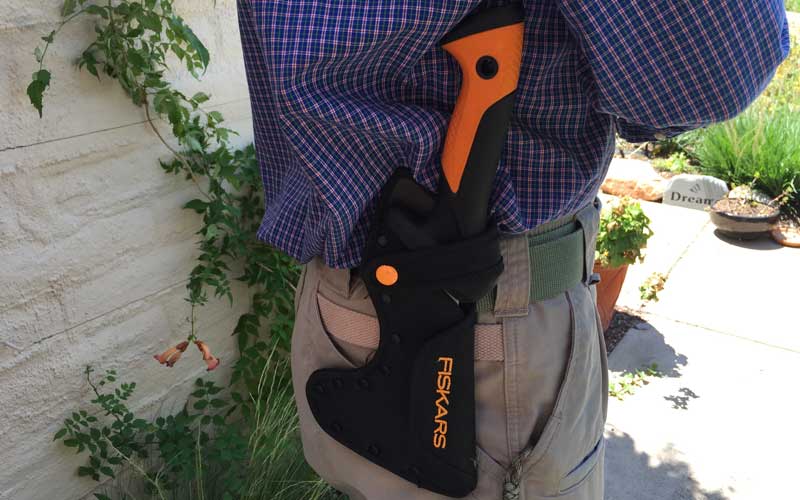
The handy sheath can be worn on a belt and protects you from all of the sharp edges.
Handle is a Perfect Size for Both Large & Small Hands
The handle size is ideal for both small and large hands – it fits into that category of not-too-small and not-too-big. The Billhook’s overall length is 13” and it weighs in at 11 7/8 ounces. The grip on the handle is about 4 ½” long and has a flared end (opposite the blade) to prevent the Billhook from slipping out of your hand.
Another feature I liked is that the grip has a molded-in piece of rubber-like compound to stop your hand from slipping.
The Billhook handle can be held on either side, one side to use the straight/curved blade and the opposite side to work the serrated edge. The handle is comfortable while working either side of the blade and Fiskars has incorporated a nice palm and thumb grip for secure purchase.
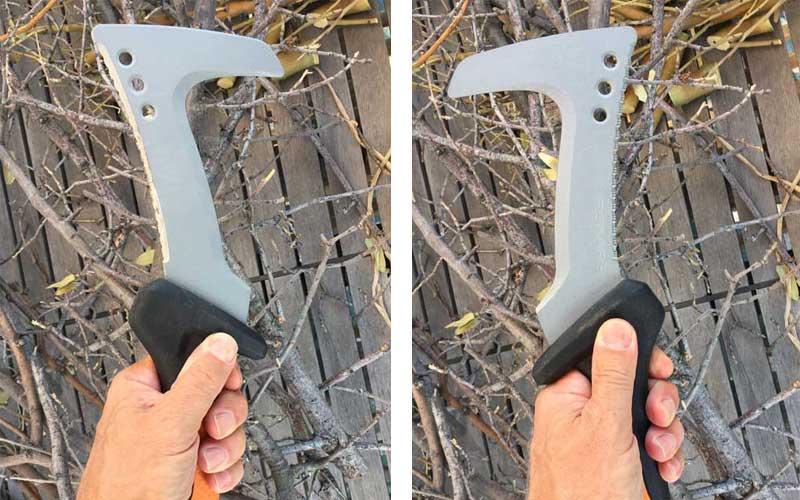
The handle design allows the tool to be comfortably used with the blade in either direction.
About the Curved Blade Design

The hooked blade gives the Billhook a lot of options for use.
The Billhook is like a hand sickle on steroids. Unlike a traditional sickle with just a straight blade (the Billhook has one of those too), it also has a unique curved part at the end of the straight blade. This “hook” adds a whole new functionality to the tool.
A nifty feature of the inside of the curved blade is that it’s very sharp and so makes quick work of a variety of projects.
The biggest benefit of the hooked blade is that it allows you to make pulling cuts instead of just sweeping cuts, making it great for cutting small branches and twigs, and cutting vines off trees. You don’t have to hack at them – just put the blade up against the far side of the stem and pull.
Excellent Chopping Power
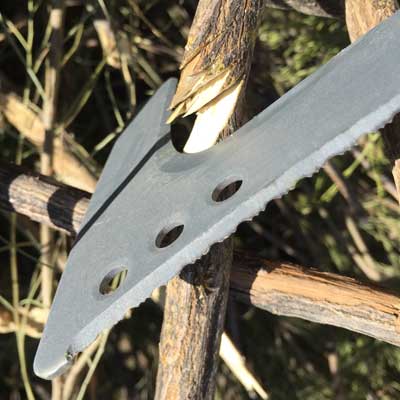
The curved blade easily chops through branches
The Billhook’s curved blade is also excellent for chopping. I was able to hack through branches and limbs with ease using the curved part of the blade. This chopping action was also useful on ornamental grasses and made quick cuts through brush.
Straight Blade
The Billhook also has a straight blade on the tool that mates with curved “hook” blade. This was my best chopping tool, allowing me to cut through 1” shrub stems with ease. Although the Billhook won’t replace pruning shears for more detailed work (like deadheading roses), for general cutting tasks it works great.
I also got creative and started making my own gardening stakes. I used the straight blade to cut off a sapling and then whittled a point on the end using a combination of the straight and curved blade. Basically, the tool made the Billhook into a mini-machete.
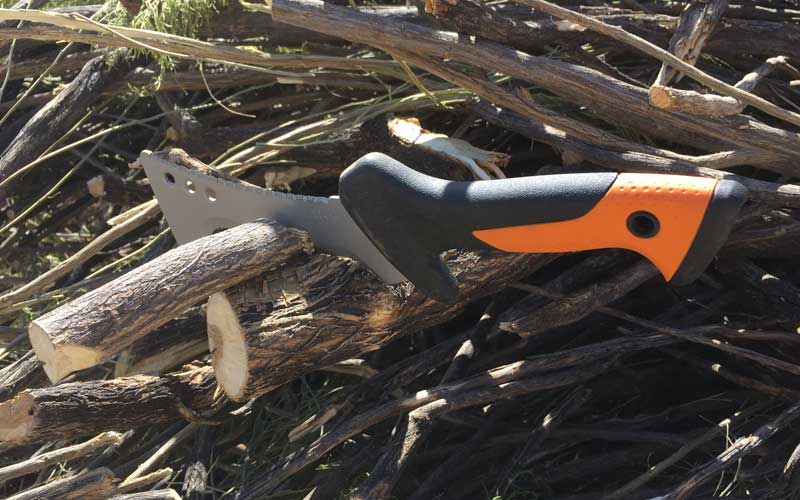
Using the straight blade to chop through 1″ material
Cuts Through Nearly Anything
I had no problems cutting through just about anything I could think of chopping through – I hacked through garden twine, paracord, dog fence wire, irrigation tubing, and more.
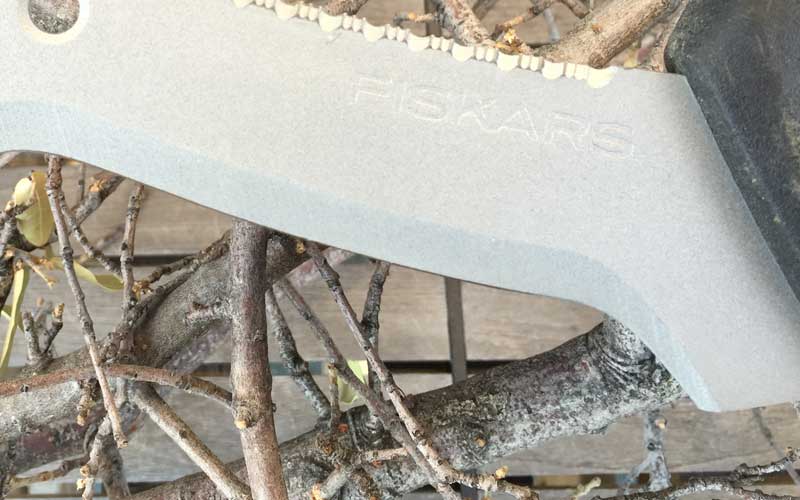
The long straight blade acts as a knife
Serrated Blade
On the opposite side of the straight/hooked blade is a serrated blade. Think of this section of the Billhook as the “back” of the tool. The entire back blade is approximately 6” long. Of that, the serrated portion occupies about 5”. This section of the tool made an excellent saw.
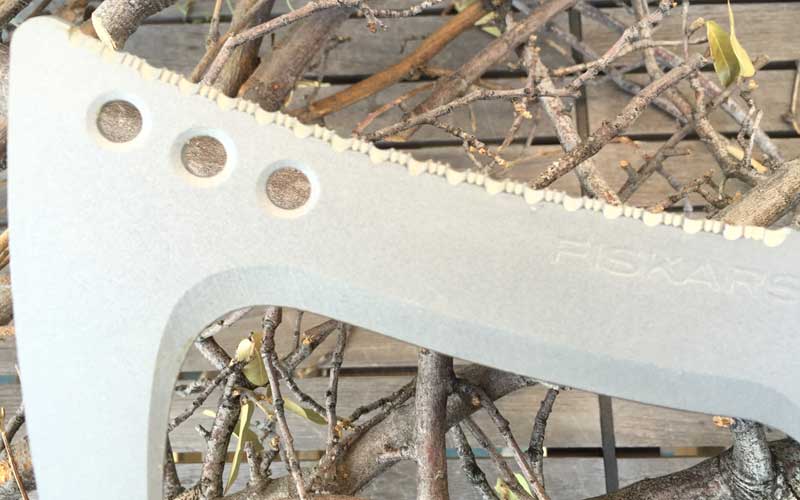
The serrated edge makes a very good saw
A Very Good Saw
My first test was to cut through some ornamental grass. I took on a large clump (about 10” at the base) and the sawing action of the serrated blade cut through this tough stuff like a hot knife through butter.
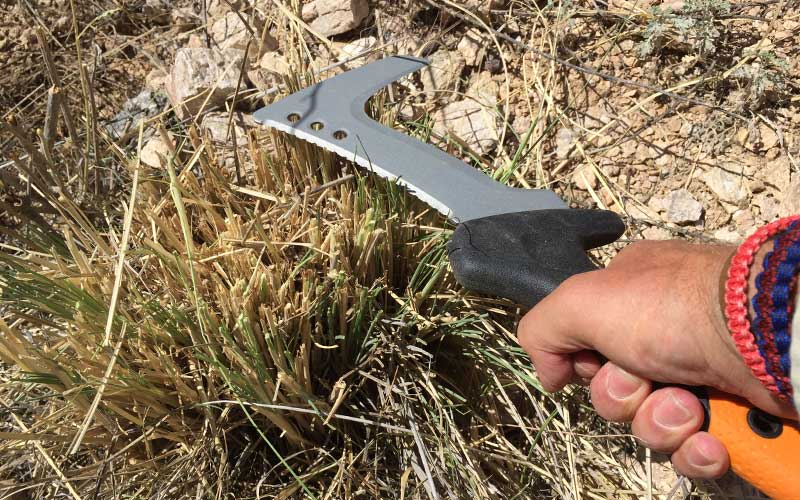
Cutting through grasses with the Billhook
Then I took my test to the next level and tried sawing down a shrub. This took considerably more effort, but it did the job and I was able to make it through all the brush. The cuts were clean, and I was able to sever the brush just above the ground, just like I did with the ornamental grass.

Between chopping with the straight blade and sawing with the serrated blade, the Billhook made quick work of cutting a multistemmed shrub down to the ground.
I then tried the serrated edge as chopping blade. This also worked, but not quite as well as the straight blade. I was however able to whittle points on saplings to make garden stakes.

The serrated edge makes quick work of whittling points for garden stakes
My final experiment with the serrated blade was to try to saw through a ¾” sapling. I didn’t think it would work very well, but to my surprise I almost cut completely through. Granted, this serrated edge is not a wood saw, nor was it designed to be (so if you need to saw a lot of thicker branches, you’ll be better off buying a pruning saw). But I was surprised that I nearly cut through a pretty sizable portion (about 80%) of the thickness of the wood.
Other Uses for the Billhook
Don’t limit yourself to just chopping and slicing – the Billhook can do almost anything you can dream up in the garden (except digging a hole). Here are some suggestions:
- The opposite side of the “hook” can be used as a scraper and to push dirt around.
- The curved hook blade will cut root balls apart and open bags of mulch, soil, fertilizer, etc. It can also be used as an edger along a walkway, sod cutter and a crack weeder (for cracks that are wider than 1/16”).
- Use it as a small twine/rope puller by sticking one end of the twine/rope through one, two, or three of the holes in the front of the blade.
- It’s excellent as a small trenching tool for laying underground wire for an electric dog fence or to bury ¼” irrigation tubing.
- The sharp blade acts as a small wood splitter for making kindling for a garden fire pit or chiminea.
- The flat side of the blade can be used as a light duty hammer for pounding in gardening stakes.
- It’s easy to use as a hand-held tiller and makes a terrific weeder.
- The flat end (opposite the hook) makes a decent scraper.
The more I used it, the more uses I came up with. It’s pretty much limited by your imagination.
Sharpening the Blade
Fiskars does not warranty the sharpening of the Billhook. But lets face it, cutting tools take a beating after a while and need sharpening, even if it voids the warranty. The straight and curved edges are easily sharpened with either a round chainsaw file (my preference is a 5/32” – orange handle in picture below), or a diamond impregnated steel hone (I use a “Smith’s” – blue handle). Because of the curved “hook”, flat files are not recommended.
I’d stay away from filing the serrated blade as it can be very tricky to get it right. If you must file it, the “Smith’s” hone noted above will do the trick, but you have to be very careful not to file off the small serrations, as this will ruin the blade. The best bet for the serrated edge is to keep it out of the dirt and areas where it would get dull. If you really need it sharpened to the correct angles and depths, I would suggest that you take it to a professional knife sharpening company who specializes in serrated edges.
And make sure to stay away from grinders. This will absolutely destroy the serrated edge (and likely the straight edge too) making the saw/blade useless. I hand sharpen all my tools and never use electric sharpers. There is too much room for error with electric sharpeners. When you make a mistake you’ve compromised the tool and may as well throw it away and go buy yourself a new one.

My go-to files for sharpening straight blades (top) and serrated edges (bottom).
Full Lifetime Warranty
Like virtually all Fiskars products, the “full lifetime warranty” on the Billhook means that “tools are warranted to the consumer purchaser to be free of defects in material and workmanship for as long as the consumer owns the product. Warranty does not cover sharpening, normal wear and tear, environmental factors, accidental damage, misuse, industrial/commercial use. At Fiskars Brands, Inc.’s option, defective products will be repaired, replaced or substituted for a product of equal value.”
Recommendation
![]() I found this to be one of the most versatile and innovative gardening and landscape tools that I’ve ever tested and it quickly became one of my “go-to” hand tools. Just when I thought I’d run out of uses for the tool, I came up with another one, not only in the garden, but in my yard as well as the overall landscape environment. If I had to, I could plant a small garden with just this one tool. Granted I wouldn’t like to do it that way, but I could with the Billhook.
I found this to be one of the most versatile and innovative gardening and landscape tools that I’ve ever tested and it quickly became one of my “go-to” hand tools. Just when I thought I’d run out of uses for the tool, I came up with another one, not only in the garden, but in my yard as well as the overall landscape environment. If I had to, I could plant a small garden with just this one tool. Granted I wouldn’t like to do it that way, but I could with the Billhook.
Where To Buy
The Billhook (13”) is available on the Fiskars website for $34.99 + 10.95 shipping. There’s also a similar 18” model.
It can be found in the garden tool section at your local Ace Hardware, True Value, and Home Depot.
Of course, the most convenient way to buy it is on Amazon for around $25 plus shipping.
And now over to you – What’s your favorite multi-purpose gardening tool? Share your thoughts in the comments below!
If you liked this review, please sign up for our monthly newsletter to get new reviews, special offers and giveaways.
Enjoyed This Review?
If you liked this review, please sign up for our email updates with reviews, how-to articles and gardening videos!

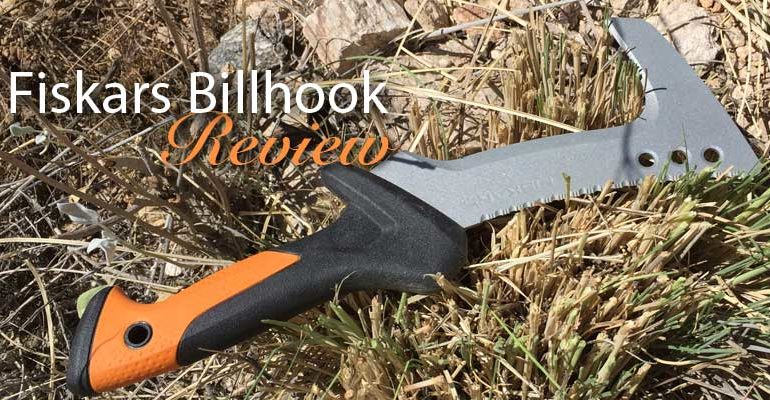




I didn’t find the “Nifty Feature” of a sharp hook on the 13 inch Fiskers Billhook, that we got. Definitely appreciate the sharpening info.